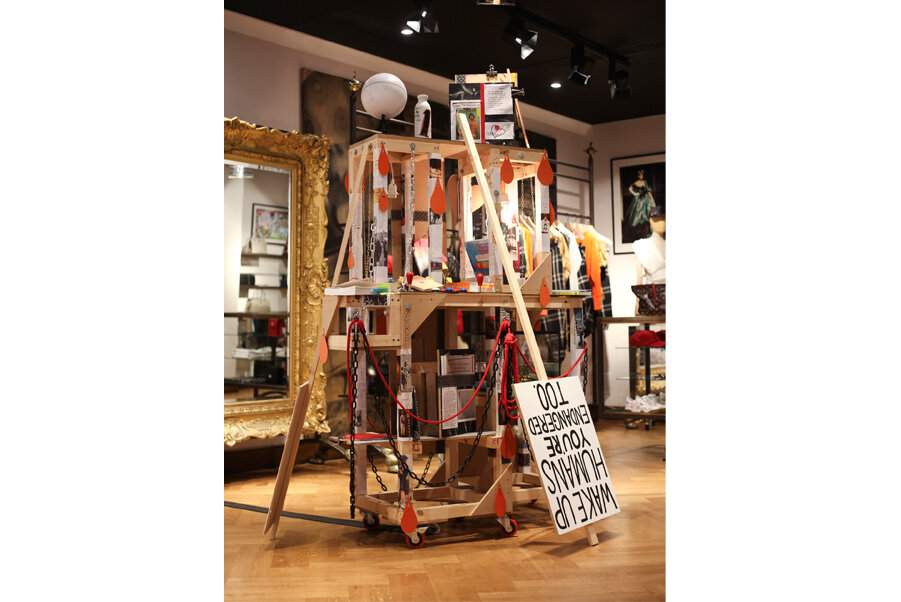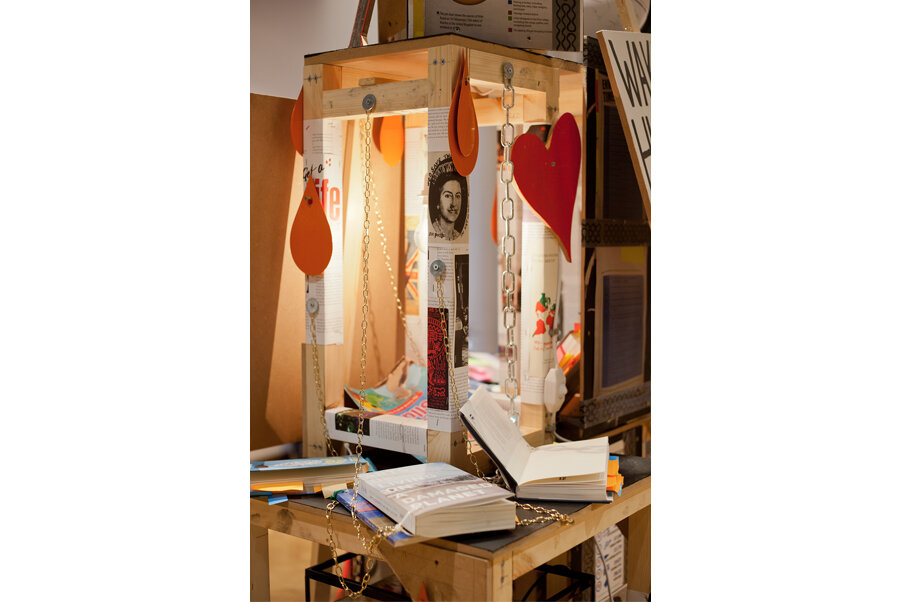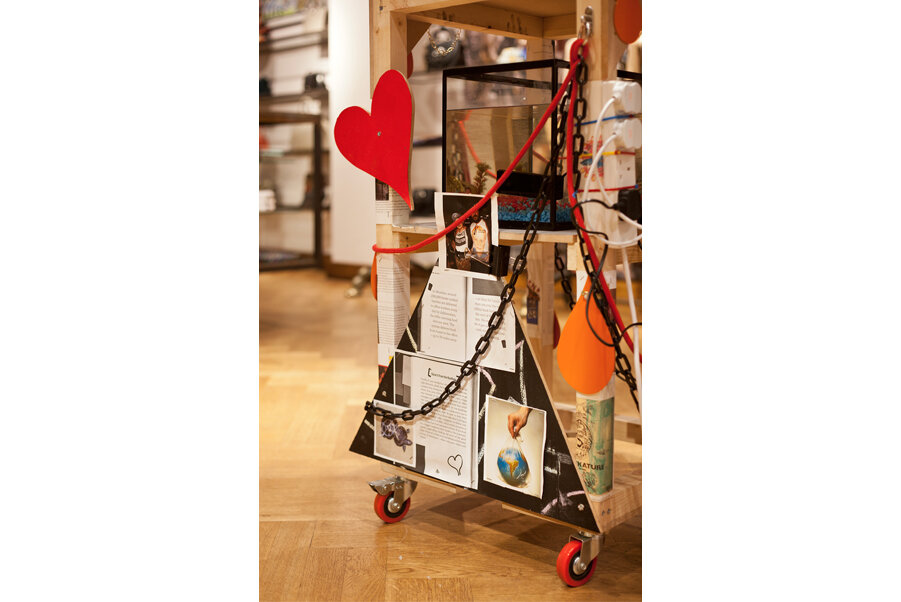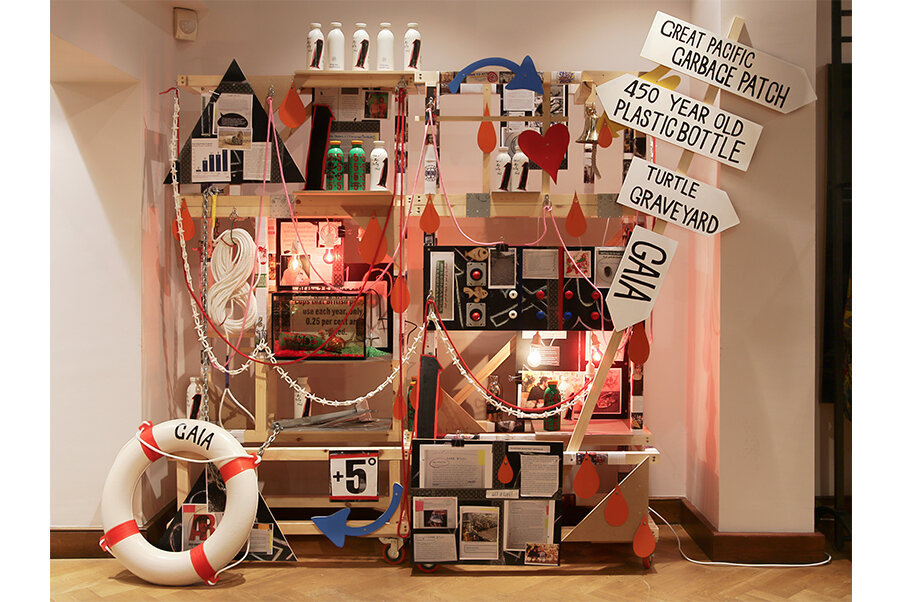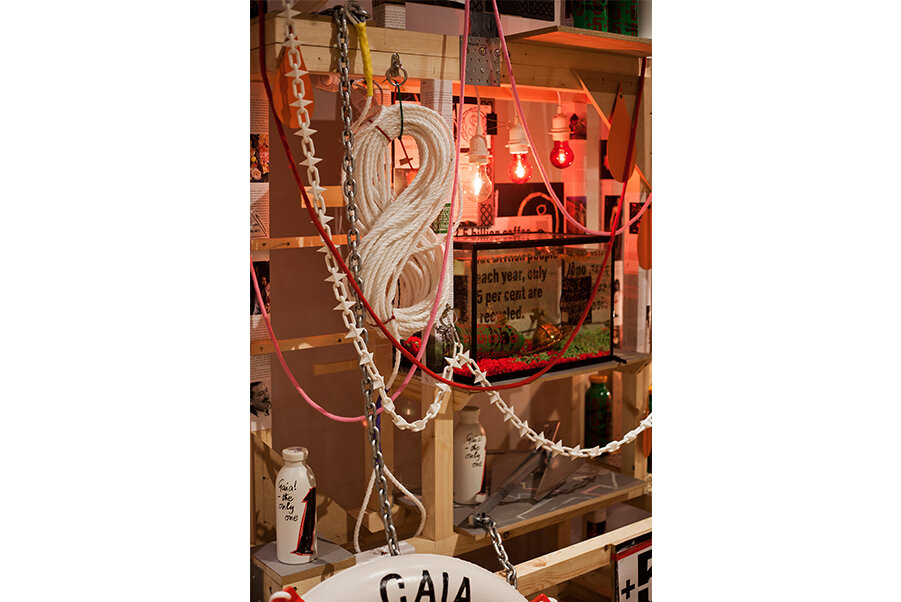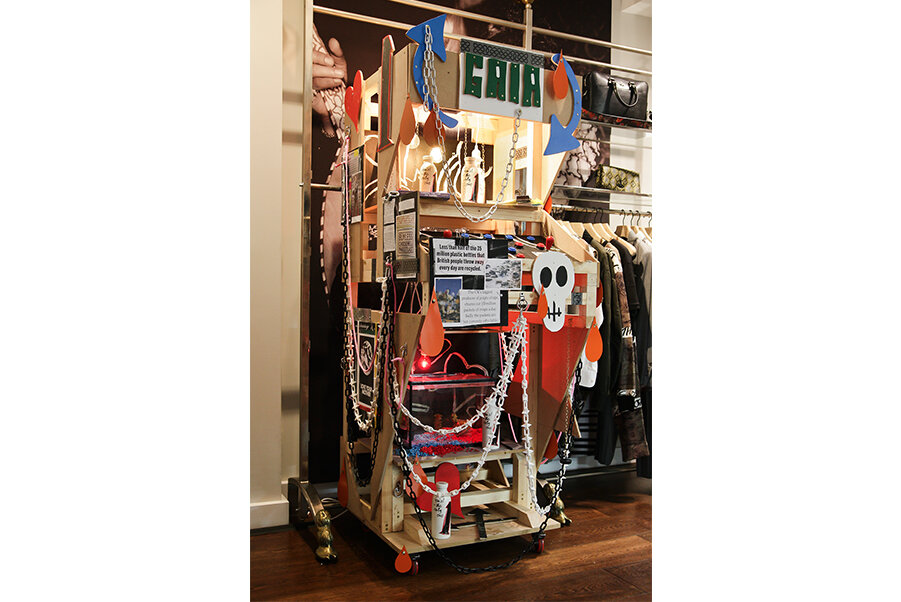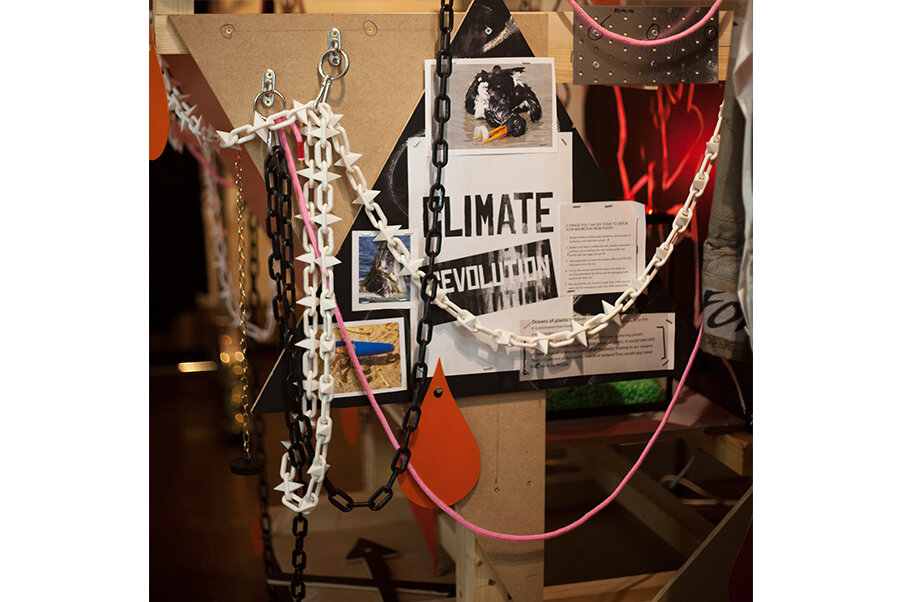RAMSES' EYES, FRANKENSTEIN'S LAST BREATH - ORGY PARK, BROOKLYN 2013
Ramses’ Eyes, Frankenstein’s last breath is a collaborative work by Brock Enright & Richard Evans that relates to interconnecting stories and the resulting ideas when two materials and artists converge. The proposed subjects/objects snow and onions were chosen after a series of conversations about the relationship between structures, materials and emotions.
- deep breath.
Onions, like snow are famous for creating romantic tearful moments on stage and screen. The lowly onion has a long history of strange, dark and romantic attachments. They have been cultivated all over the world for food and ritual practice for 5000 years. Onions were an object of worship in ancient Egypt and were found in the eye sockets of King Ramses IV’s mummified remains. Recently archeologists have supposed that ancient Native Indian cultures incorporated them into toys. Today the Internet even claims them as a back up battery for your iphone.
In the installation onions and objects are presented with steel rods, which act as both the conduit for ideas and also a means to separate them acting as a structure, a barrier, a map and a visual foil. They have an aesthetic purpose but also a practical one, as these rods carry an electrical current between the onions to power two snow machines.
The onions and various other objects rest on plaster shelves. If the steel structure is the skeleton then the shelves are the skin of the work. They are cast from found cardboard boxes and incorporate small geometric objects. Visually they resemble codes or hieroglyphs, abstract shapes from an ancient or future tomb.
The arrangement resembles an illogical shelving system, structurally unsound crypt or research lab created by an artistically inclined rebel scientist. Maybe one who is searching for a metaphor? They become an analogy of a world that is a flawed, self-regulating technological system (powered by onions).
The Frankenstein relationship is further echoed in the fake snow. The moment in Mary Shelley’s book where Frankenstein’s monster becomes separated from his maker’s ideals is often seen as the moment when the monster’s friendship with the blind man (seduced by his guitar playing) is shattered by the arrival of the man’s son in the winter snow. The son exposes the illusion of trusting pure innocent aesthetics, destroying it with the reality of society, culture and technology.
This insight is mirrored in the work. We realize Ramses’ Eyes is a con and that onions could not possibly run snow machines (or iphones) but it also points us towards the idea that maybe emotion can be generated by a power beyond the practical means of objects, a power that resides in the blind optimism and illusion of art.
C.A.G.E - FILM SCREENINGS - GREENPOINT FILM FESTIVAL - CROWN HEIGHTS FILM FESTIVAL - PORTLAND SUMMIT OF MUSICAL IMPROVISATION - 2013
C.A.G.E. is a fictional documentary about ‘Variations on a Plain Index’ a 1945 sound work by an unnamed experimental composer.
C.A.G.E. is a subtle and philosophical story about an artist’s relationship to environment and how component elements of an artwork can represent subjective states of mind.
C.A.G.E. refers to a psychological or physical cage, to the notes C, A, G and E which make up the final noise, the sound experiments of John Cage and the actual names of the mine shafts in Skidoo Mine, Death Valley.
The composer records the wind in an old forest in Capitol Reef National Park and then plays that recording in disused mine shafts in Death Valley using a multi channel recording process. Here the channels are not electronic but physical channels, mineshafts. The noise of the wind is played and then re-recorded in the mines. The resulting recording is a sonic description of the shape, volume and materiality of the shafts, a representation of the sordid culture and history of the mine and an elegy to the horrific past of the dead forest.
The film follows the sound work through several stages; natural, electrical, mechanical, geological and acoustic. These changes of state are echoed in the levels of the ‘family tree score,’ the system used to make the recordings in the mine. This process involves the pairing up of recordings made in several mines, re-pairing and re-recording them until there is only one recording.
This single recording is encased in plastic and ‘exhibited’ in an unmanned electrical substation. This sound is a physical distillation of identity, history, landscape, process and technology.
IT'S ENDLESS UNDOING - THIERRY GOLDBERG 2012
Press release – Its Endless Undoing – Thierry Goldberg – New York – June 2012
NEWSPEAK, BRITISH ART NOW - THE SAATCHI GALLERY, THE HERMITAGE, ART GALLERY OF SOUTH AUSTRALIA 2009-2011
Harpers Bizarre - Saatchi Gallery in Adelaide - Australia - 2011
The Advertiser – Saatchi Gallery in Adelaide – Australia – 2011
Adelaide Now - Saatchi Gallery opens British Art No2 - 2011
The Telegraph – Newspeak II - The Saatchi Gallery – London – 2010
PORTA – Newspeak – The Hermitage – St.Peterburg – 2009
THE PENCIL SHOW - FOXY PRODUCTION 2010
ARTINFO – The Pencil Show – Foxy Production – New York – 2010
AMHHA - SOUTHFIRST 2011
Press release – AMHHA - Southfirst – New York – November 2011
SOUTHFIRST is proud to present “AMHHA,” an exhibition of new drawings and 3-D studies by Richard Evans. The show is on view from 7 October – 6 November, 2011. The title is an acronym of the name of a work by electronic musician Morton Subotnick, All My Hummingbirds Have Alibis, which described a series of “imaginary ballets” based on the collage novels of Max Ernst.
Fanagalo (2011) is a series of six framed photographs of sculptures. The objects resemble Surrealist sculptures or African ceremonial objects. Their presentation echoes early-Twentieth century photography of Modernist sculpture like that of Giacometti or Jean Arp; small, black-and-white photographs in tight black frames, setting off moodily lit fetish objects. The title comes from the pidgin language used as a lingua franca in South African gold, diamond, and copper mines. A complementary series, Objcts (2011), feature in three color photographs from a series based on quasi-Surrealist sculptures which reference Max Ernst maquettes.
Another sculptural series is loosely grouped around the theme of sound. It features guitar strings threaded through fine art materials: a block of alabaster, a concrete box. The works reference Picasso’s guitar collages and some of the play and metaphorical material explorations of synthetic cubism. IIII_Interior (2011) highlights the vibratory potential of material like Perspex, plasteline and dust. Some sculptures are studies in the interdependency of materials, such as Zzwik (2011) collapsed polyurethane rubber on a steel armature; other pieces utilize concepts or props from Evans’ blog A Moment of Eternal Noise. Kassel is a ‘geo-audio’ drawing which relates to stories about the secret use of sound and underground resistance in World War 2 Germany.
Evans’s explorations seem nostalgic for a between-the-wars Modernist style, referencing names and exhibition strategies from the 1930s. Yet the show also playfully reworks materials, imaginary systems, and anti-form tactics.
ARTINFO – AMMHA - Southfirst – New York – 2011
NUL - FOXY PRODUCTION, NEW YORK 2009
Press Release – NUL - Foxy Production – New York – 2009
Foxy Production presents NUL, a group exhibition curated by London-based artist Richard Evans. Nul brings together seven European artists, including Evans, Salvatore Arancio, Anders Clausen, VALIE EXPORT, Simone Gilges, Lars Laumann, and Nedko Solakov, whose work relates in differing ways to loss, reduction or vacancy. Combined, the works in Nul produce an uncanny sense of dissolution.
Salvatore Arancio’s photo etchings depict bizarre natural phenomena in strange ancient landscapes. Collages of the old and new, they trade on the aesthetic pleasures of visual histories. They embody a fantasy of Gothic nothingness that is underscored by a surreal desire.
Anders Clausen’s sculptural heads on wooden pedestals elicit a curious familiarity, with their combination of the allegorical and the historical. His zombie-like figures have reduced their art historical references – to Jacob Epstein, Ben Nicholson, and Dieter Roth – to a humorous yet subtle amalgam.
Richard Evans’ Plexiglas boxes – titled by their dimensions – consider the possibility of absolute zero. These almost empty vitrines contain remnants of works that have been abandoned by the artist, left to gather dust in a corner of his studio for a year. Hygiene products, wax, candles and dust produce landscapes of comic emptiness that are at once a portrait, an environmental calendar, and an image in negative of his studio.
VALIE EXPORT’s sculpture Dead People Don’t Scream pointedly references an existential interpretation of nothingness, visualizing the experience of an emotion so extreme that a face becomes a terrifying vacuum. Her photographic series, untitled, presents stony figures intertwined with angular architectural structures, creating a dynamic tension between the construction of identity and its dissolution.
Simone Gilges produces very particular and concise arrangements of photographs and objects. For Nul, Gilges places re-photographed images, fabrics, and found objects in enigmatic relationships with one another. She presents a constellation that is mysterious, monstrous, conjured and ethereal. The work’s elements coalesce in a psychological scene of both curiosity and closure.
Lars Laumann’s Hatful of Cocteau is a screen-print of an article from an issue of La Liberation devoted posthumously to Jean Cocteau. It includes an image of a man with an illustration from the artist’s publication Le Livre Blanc tattooed on his shoulder; the same image was also used on Morrissey’s Hatful of Hollow album cover. Laumann’s work focuses on how images and objects can act as both romantic connectors and empty ciphers.
Nedko Solakov’s Personal Parts drawings combine body parts with poetic writing about them, engendering strange insights into the human body as a whole. Simultaneously comedic, macabre and enlightening, they are dark fables about people reduced to their elements.
The Jewish Museum Blog – NUL - Foxy Production – New York – 2009
...discussing exhibition design in its show Flat Pack as inspired by NUL at Foxy Production…
THE SWAN AND THE SPECTRE - URA, ISTANBUL 2009
Catalogue Essay – The Swan and The Spectre – URA - Istanbul – 2009
The Last Man – Essay for the catalogue Rooms in Daylight, used like dark woods for the exhibition The Swan and The Spectre at URA Gallery Istanbul
I’m in Evans’ studio in south London. A photographer is here to document the work The Swan and the Specter and the flash bulbs are going off. Evans chooses a moment to hand me a reproduction of a Diane Arbus image shot in Disneyland in 1962. Taken at night in wistfully kitsch soft focus Castle in Disneyland, Cal.62 captures the facade of a fabricated European castle – complete with swan-upon-a-moat. The archetypal castle is illuminated by affected moonshine that does not disclose any onlookers.
Presumably the original structure no longer exists, and forty years on, Evans revisits the scene and converts the image into a three dimensional representation. Without demystifying Arbus’ subject he embraces its theatrics and conjures a conundrum that is neither image nor wholly an object. Costumed from polystyrene and coated entirely with glistening volcanic sand, Evans’s remake disallows one to walk completely around the structure reminding one that it too is but a façade. It sparkles seductively but with an ulterior motive. Thinking back to holidays in Costa Whatever, of miles of inert coastline under flat skies the experience at times was not unlike being in vast, expanded morgue. Evans seems to have gone one up and found one devoid of heat and made from gothic black sand. From its shores a castle seems to have appeared like a mirage…or apparition.
The spectres in The Innocents, a film Evans much admires, appear suddenly when the new governess Mrs Gidddens uncovers dark secrets about her late predecessor and her employer’s dead valet. Believing they have returned as demons and have possessed the children she is caring for, the apparitions become more frequent when she presses children on it. It isn’t clear whether the children are possessed or Miss Giddens is delusional but the faces that appear without will at windows and over lakes seem to be stand-ins for sublimated memories and displaced moral repression.
“ROOMS IN DAYLIGHT, USED LIKE DARK WOODS” is line from the film that is uttered in a formal Victorian style out of synch with the speech of the times used by the characters. Like a linguistic demon, it returns to the lips the prim nanny who, living with the memories of the sexual goings of the valet and his lover, lets it slip as she comes to terms that her attempts to sweep past events under the carpet have been in vain.
Similarly, The Swan and the Specter revisits us as an embodiment of the darker associations with childhood that we tend to keep at arms length. As an antidote to the ‘pure as the driven snow’ white exteriors of the castles that Disney peddles, our charred structure is the demon brother, which, like a septic sponge, has absorbed unspoken abjection. The scale of the work is difficult to pin down. Is it an enlarged sand castle, or has a life-sized one shrunk under a malicious spell? Or perhaps, it has physically embodied the size in was it perceived in the distance as a mirage, lodged on retina of the beholder as an entity that can never be reached. Stuck in some kind of limbo between worlds of the real and the imagined, the living and the dead, The Swan and the Specter comes to stir sublimated memories that we might prefer to remain well and truly buried.
The monochromatic palette is a rule of thumb for Evans, and it makes for a similarly tainted world in which an array of objects, situations and mise en scène laced with subtle existential presence emerge. Scenes such as T25, 2007 in which an abandoned floppy rucksack nests on a pile of black synthetic sand. Over it looms a light used to accelerate growth in horticultural cultivation, that’s proximity to the bag is as invasive as an integration lamp – and just as suspicious. Although it seems to point the finger, it to is complicit in the scenario as it becomes apparent that the type of horticulture might be of the psychotropic kind.
Drawing on a shift made in the collective psyche in recent times that has seen the ubiquitous rucksack go from banal accessory to a sinister and feared object, the vignette is an unpleasant reminder of the relationship between drug culture and violence. It is not clear whether the sense of threat that Evans’ sculpture prompts is real or is the kind of super-skunk induced paranoia of the user. Like the hysterical figure of Mrs Giddens whose suspicions might be well founded, it might also be the case that the mind has fallen victim to psychotic hallucinations.
The sculpture Black Grape, (2006) fashioned from similar inert terrain as The Swan and Specter, freezes the moment of becoming giving a neat spin on a trend evident in British catastrophe science-fiction popular at the turn of century. In M.P Sheil’s The Purple Cloud for example, the author slightly tweaks natural benign everyday phenomena, imbuing it with a creeping otherness. Exploiting one’s sense of awe – philosophical or otherwise –novels such as this upped the ante on nineteenth century ideas of the sublime. When many of the novels were made into films, the genre almost fared as a ‘ fear industry’ that according to contemporary film academics exploited sublimated social fears of the start of a new century.
If Evans uses a similar techniques, than he does so to possible to address displaced or unresolved ontological issues which in some critical circles have but all been dismissed. To ‘talk Existentialism’ might be as fashionable as wearing the proverbial black polo neck, but Evans is restless with the notion.
‘Last Man’ literature is a term given to a sub-genre of post-apocalyptic fiction that typically focuses on the lone survivor wandering recently deserted cities or finding himself in an empty rural village. The cause of evacuation is almost always unknown, and the dilemma of the protagonist is to try and make sense of his predicament against a ticking survivalist clock. The parallel with the Sartrean imperative that Man is alone in the world is striking, and illustrates a constant process of (self) discovery.
A wasteland such The DX Project offers the perfect opportunity for one to act the last man, as one treads blackened vegetation and attempts to decipher gnarly debris caught in twisted fences. In the name of a ‘ project’ that has had obvious catastrophic results, The DX Project is an example of overtly representational exploits to explore the void contextualising the process through a mise en scène of abandonment. The proposition is simple but effective. By erecting fences that mark a set of limited boundaries, Evans then goes and rigs them to receive radio transmissions. In modifying the dumb structures to receive infinite soundscape it is as if he has given life to the structure – and its debris. However, without any decipherable traffic passing through the installation’s veins the result is a hum of white noise that exasperates the sensation of isolation and helplessness.
The lone thinker. The drunkard. The madman. The flâneur. The autodidact. The ‘last man’ is just an extension of the solitary figure that gained prominence in ‘ solipsistic lit’ and it is the kind one imagines to have been incarcerated a solitary life-sized cell constructed by Evans in 2009.
On the Indestructibility of our Essential Being by Death takes its name from a chapter in ‘On the Suffering of the World’ by a figure of brooding brandy soaked philosophy himself – Arthur Schopenhauer. Recalling Orphe’s underworld, it imitates – perhaps unwittingly – stage scenery of early cinema, captured within a contemporary hard-edged steel unit. A melancholic moon is squeezed in like a dumb appendix, playing its part pictorially in the background of another deserted castle. Wax dripped over bricks has built up like lime scale, and is subjected to a constant lick of milky water that runs down drains into gutters to nowhere.
Fighting awkwardly for prominence are various abandoned articles of clothing and discarded objects. Leather jackets fashioned from white resin has grown some arteries and together with a folded futon covered with slithering varicose veins have leapt ontological categorisation to join the organic order. Elsewhere a discarded boot and a glove with long exaggerated spikes lies near scattered fragments of porcelain. With the evidence in mind, could this place be the final dwelling of a rock star – the last rocker perhaps – a figure perceived to embody a lifestyle of reckless abandonment that to the contemporary eye might look passé? Is it a parable of lost identity, that because of a shift in contemporary standards of excess, a last ditch to regain kudos results in his drugged psyche fusing with his leather gear?
Object and subject fusion – designed to upset the status quo – is an old trick, and one well used in conventional horror and pulp apocalyptic visions. Ham-fisted engagements with the ‘moment of discovery’ aside, Evans uncovers many interpretations of an elusive subject we might label Being. However, surfing through romantic literature, British horror films and unfashionable philosophy, his findings turn out to be articles of artifice themselves. That is not to say he is a po-faced ironist, on the contrary, he might (rather like his predecessors) be said to suffer from niggling feelings of unfinished business with Being – even if it has now been relegated to the special effects department.
Cameron Irving, 2009
ON THE INDESTRUCTIBILITY OF OUR ESSENTIAL BEING BY DEATH - BOYSCHOOL, LONDON 2009
On The Indestructibility of our Essential Being by Death, press invite. Boyschool, London, 2009.
Press Release – On The Indestructibility of our Essential Being by Death – Boyschool – London – 2009
A crack appears in the comfortable marriage between the physical world and our individual consciousness. The world melts and the difference dissipates. As if a tidal lock, the doors are opened, the cavity fills and the ship glides into a flooded world. The body revolts against the skin and our veins grip the earth, parasites fill the sky, tombstones become dust, the moon falls and the earth rises. Our mortal coil drops and a revolution begins. An egalitarian lifestyle of mental and physical equality has started to evolve. A new utopia of form is created where the sphere can fit into a box and the heart pours blood onto a lifeless stonewall.
This unnerving work, made especially for boyschool gallery, considers our subjective relationship to objects and our faith in the solidity of the world that we inhabit. Each element in the work examines a material state, and a mental disposition.
Through fountains, drips and veins, the materials depict a flux between states from liquid to solid to gas. The wax, plastic, resin, steel and water reflect the psychologically unanchored position of the individual.
Our mental attachments to objects are brought to a discomforting conclusion where aesthetics and structures are interchanged and instinctual systems are forced to reevaluate themselves. The work presents the intangible space between the physical world and our subconscious; where trauma, desire and compulsion manifest. It is both an illustration of how the world could look through the lens of an intellectual mediation, such as in Sartre’s Nausea, and a portrait of an other worldly fantasy such as Orpheus underworld.
Here our subjectivity has shifted from us to it; an it that could become a they.
THE HIDDEN - MAUREEN PALEY, LONDON 2008
Franscesca Gavin - Dazed and Confused – The Hidden – Maureen Paley – London – 2008
Ossian Ward - Time Out – London – 2007
MASK - JAMES COHEN GALLERY, NEW YORK 2007
New York Times – Mask – James Cohen Gallery – New York – 2007
SOLO SHOW - MAUREEN PALEY, LONDON 2006
Untitled – Maureen Paley – London – 2006
Terma Celeste – Maureen Paley – London – 2006




